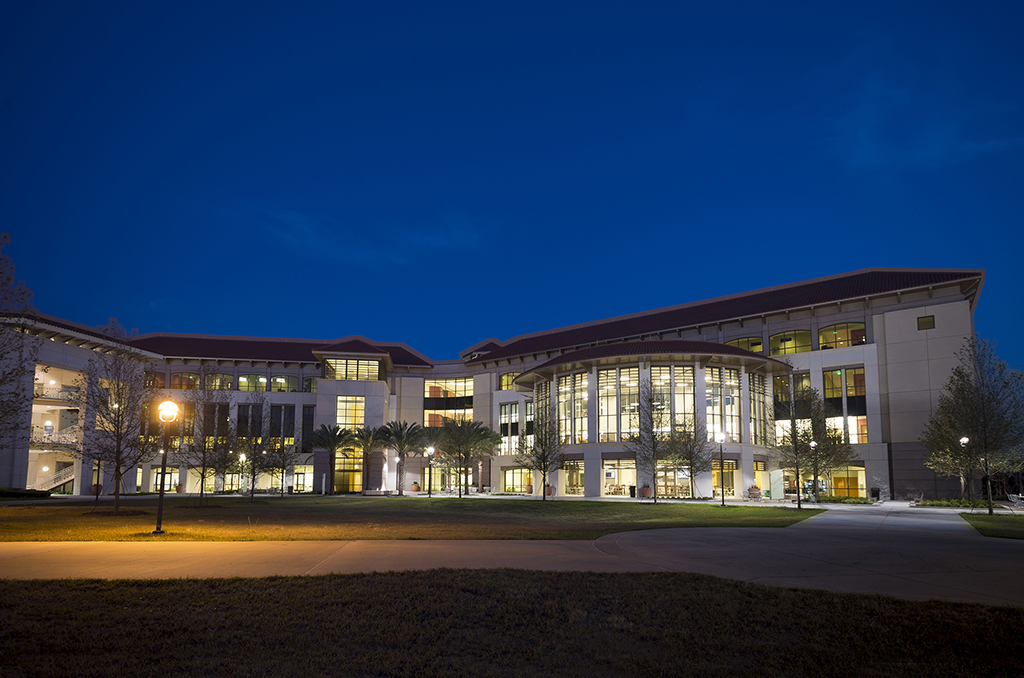Orlando, FL – Valencia College’s newest building, Building 4 on the Osceola Campus, has received LEED Gold certification in recognition of the building’s energy-efficient design and construction.
LEED, which stands for Leadership in Energy and Environmental Design, was created by the U.S. Green Building Council to provide architects and builders a framework for creating energy-efficient buildings. This is the fourth building at Valencia to earn a LEED Gold designation.
Designed by HuntonBrady Architects and built by contractor Clancy-Theys, Building 4 contains 150,000 square feet of classroom and office space and is the largest building on any Valencia campus. Opened in January 2013, the $35 million building is home to the Osceola Campus library, science classrooms and labs, the campus bookstore, computer labs as well as a campus cafeteria and coffee shop.
LEED certification provides independent, third-party verification that a building was designed and built using strategies aimed at achieving high performance in key areas of human and environmental health: Sustainable site development, water savings, energy efficiency, materials selection and indoor environmental quality.
LEED Gold is the second highest level of energy efficiency attainable. Only LEED Platinum is higher.
During the design process, Valencia officials asked the architecture team to aim for LEED Silver certification, but noted that they would prefer LEED Gold certification, but only if it did not increase construction costs. “As it turns out, we received enough points to put us well into the solid Gold territory, and we were only a few points away from LEED Platinum,” said Maurizio Maso, vice president of HuntonBrady.
For the architects and contractors, Building 4 presented a challenge because the building houses 10 science laboratories. “Labs are challenging in terms of sustainability because they require a lot of air-changes – which doesn’t help the energy-efficiency of the building,” Maso said.
The building’s energy-efficient features include: high-efficiency air conditioning, dual-flush toilets and green materials used in the floors, walls and ceilings. Building 4 has a cistern which stores 10,000 gallons of rainwater for flushing toilets. In addition, the building’s roof is covered with white reflective coating, designed to reduce cooling costs.
The building also features smart lighting, which dims or turns off the lights in a classroom if there’s enough light coming in from the windows. In hallways and in classrooms, lights are also connected to motion detectors – so they’ll shut off the lights when there’s no activity in an area.
In addition to the energy-saving features inside Building 4, the landscaping plan uses native plants, which require less irrigation.
“During the last few years, we have worked very closely with our architects, engineers and contractors to design and deliver very functional and energy-efficient buildings,” said Keith Houck, vice president of administrative services. “We are proud to say that in the past six years, Valencia has built six new buildings, but the new buildings are so energy efficient that, combined with our new air-conditioning systems, we’ve reduced the college’s overall energy costs while increasing the amount of classroom space.”
Valencia College has constructed six new buildings since its 2006 commitment to build only to LEED Silver or above, or the equivalent. The first three were built on West Campus in 2009 and 2010, and each was awarded LEED Gold certification.
Valencia’s three other LEED Gold facilities are: the Allied Health Sciences building, the Special Events Center and the University Center (Building 11), all of which are located on Valencia’s West Campus.
The college has also used an alternative certification, the Green Globes system, at other sites. The Lake Nona Campus, which features an 82,000-square-foot energy efficient building, has been certified as a three Green Globes building – which is the equivalent of LEED Gold. Likewise, Building 10 on West Campus, which opened in Jan. 2013, also earned three Green Globes.
The Green Globes certification system is operated in the United States by the Green Building Initiative.

Comments are closed.